Why Is My Cat Chewing On Everything?
From kibble to cable wires, here’s a peek into your cat’s chewing habits — and how to decode their behavior when they’re nibbling on all the things.
From kibble to cable wires, here’s a peek into your cat’s chewing habits — and how to decode their behavior when they’re nibbling on all the things.
by Janelle Leeson, | August 18, 2025

Helen Rushbrook / Stocksy
Plants, plastic, cables — if you live with a cat, odds are these have all ended up in their mouth at some point. One of my cats chews on Styrofoam if given the chance. The other chomps our houseplants to get us out of bed — then pukes them up for good measure. Believe it or not, there’s usually a reason behind all this chewing. Understanding why your cat chews on everything can help you redirect the behavior toward safer, less destructive outlets.
TL;DR: Your cat may be suddenly chewing on everything due to anxiety, a medical condition, or even just because they realized it’s an activity they enjoy. While adult cats don’t usually chew as much as dogs, it is a normal behavior. Still, depending on what they chew, it can be annoying to you and dangerous to them. That’s why it’s important to redirect their chewing away from harmful objects.
It can be hard to tell what’s normal when it comes to your cat’s behaviors, and sometimes the answer isn’t always black and white. Chewing is one of those cat behaviors that’s totally normal — until it isn’t. As with human babies, kittens explore the world with their mouths, so chewing during kittenhood is not only normal but to be expected.
“Most cats grow out of heavy chewing as they mature, but some may keep the habit if it becomes a form of play or comfort,” Dr. Dean Vicksman, veterinarian and board president of EveryCat Health Foundation, says.
Some cats enjoy gnawing on cardboard, crinkly balls, or shoelaces. It can be entertaining, soothing, or just part of how they interact with their environment. But if your cat suddenly starts chewing out of nowhere, is chewing and swallowing non-food items, or gets so fixated that they lose interest in anything else, it could signal an underlying issue.
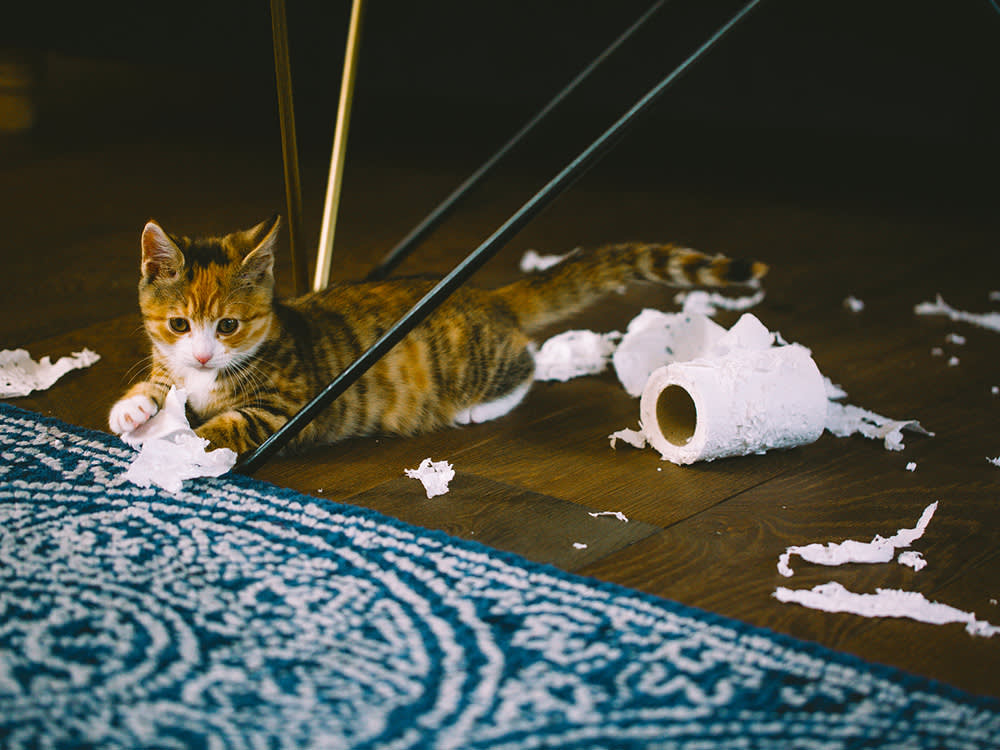
Tips on how to decode your cat’s chewing habits when they’re nibbling on all the things.
A study of 126 cats found that certain household items are particularly tempting to chew, and in some cases, to swallow. Here’s what topped the list, from most common items cats chew to least common:
Shoelaces or thread
Plastic
Fabric
Rubber
Paper or cardboard
Wood

vladans / iStock
Just because chewing is natural doesn’t mean it should be ignored, especially if it’s a new habit, happens nonstop, or leads to your cat swallowing things they shouldn’t. Here are six reasons why cats tend to chew things.
As long as your cat isn’t hurting themselves, damaging belongings, or swallowing things they shouldn’t, a little chewing can be a normal way for them to explore their world. Cats are especially drawn to objects with interesting smells, textures, or movements.
When cats don’t get enough playtime or don’t have access to stimulating environments, they’re more likely to engage in unwanted behaviors, such as destructive chewing and scratching.
Big changes, like a move or a new pet, can cause anxiety in cats. Even smaller disruptions, such as rearranging furniture, construction noise, or a stray cat outside the window, can be stressful.
Some cats turn to chewing as a way to self-soothe. “Stress-related chewing is often paired with other changes, like hiding, over-grooming, or being jumpier than usual,” Dr. Vicksman says. “If chewing becomes constant, damaging, or paired with other repetitive behaviors, it may be compulsive.” In cats, compulsive behaviors most often look like nonstop chewing, overgrooming, tail chasing, or excessive meowing.
Cats quickly learn that certain behaviors grab our attention fast, whether it’s chewing on houseplants for an earlier breakfast or something else. These behaviors can become reinforced when we respond by giving in.
Periodontal (dental) disease comes with painful chronic inflammation of the gums and tooth loss that may drive your cat to suddenly start chewing on everything. Other signs of dental disease in cats include:
Excessive drooling
Blood-tinged saliva
Bad breath
Dropping food from their mouth
Pica is the tendency to not just chew, but eat non-food items. The exact cause in cats isn’t fully understood, but evidence suggests it may be related to boredom, gastrointestinal issues, nutritional deficiencies, early weaning, breed tendencies (Siamese and other Oriental breeds), compulsive behavior disorders, or even a combination of those factors.

Regular vet visits are key to keeping your pet healthy. Here’s what happens during a checkup, when to get them, and what to bring.
Chewing doesn’t just risk destruction of your belongings — it can be downright hazardous to cats. Electrical cords, toxic plants, and small items can all pose serious risks. Cats may also swallow things such as foil, plastic, hair ties, or string, which can lead to intestinal blockages. Sudden, destructive, or compulsive chewing may be more than just a bad habit. It could signal an underlying medical or behavioral issue worth discussing with your vet.
Anytime you have questions about your cat’s behavior, especially if it’s new, sudden, or paired with other concerning behaviors like excessive meowing, over-grooming, or a decrease in appetite, it’s time to talk to a professional. “A professional can identify triggers, build enrichment plans, and coordinate medical and behavioral support,” Dr. Vicksman says.

koldunova / Shutterstock
If your adult cat was never a chewer and the behavior has manifested suddenly, it’s a good idea to pay a visit to the vet just as you would with any other change in your cat’s habits. Once a medical issue has been ruled out, you can focus on trying to prevent inappropriate chewing. Here are tips to help prevent chewing.
When you’re a cat, your day revolves around hunting. And yes, even housecats still want to feel like predators. “So, this essentially means that we have wild animals living in our homes,” Samanatha Bell, cat expert at Best Friends Animal Society, says. “They need to bite, scratch, and hide, so we need to provide them with things they are allowed to bite, scratch, and hide in.” Silvervine sticks, cardboard scratchers, or soft plush toys are all things cats can safely sink their teeth into, whether they are mimicking a hunt or simply enjoying the oral stimulation.
It’s not just about biting into prey — the hunt that comes before the “kill” is equally as important to cats. Cats have a natural predatory cycle: hunt, catch, bite, eat, sleep. The best ways to play with your cat will mimic this cycle. Wand toys and feather teasers are great for simulating the chase.
Ending a play session with a toy they can sink their teeth into, as well as a treat or small meal, helps close the loop. It signals to your cat’s brain that the “prey” has been caught and eaten, and it’s time to recharge with a nap.
Creating a stimulating environment helps keep your cat’s mind and body busy, and they will be less likely to find entertainment in chewing on your phone charger. Dr. Vicksman recommends offering them vertical spaces like cat trees, shelves, or window perches to encourage climbing and exploration. Food puzzles, interactive toys, and crinkly tunnels are also great additions to a cat-friendly home. Basically, the more mentally and physically engaged your cat is, the less likely they are to chew on everything in sight.
Creating a cat-friendly home might also mean doing a bit of cat-proofing. Make chewing less tempting by keeping plants out of reach, using cord organizers, and removing materials your cat finds especially enticing.
A consistent routine is one of the best ways to reduce stress in your cat’s life. It can also help curb attention-seeking behaviors if they’re tied to food. When cats know when to expect meals, they’re less likely to pester you or act out to get your attention. For instance, rather than free-feeding them, offer multiple small meals throughout the day. Even if you’re not home, an automatic feeder can keep mealtimes predictable.
When you catch your cat chewing on something appropriate, let them know they’re doing something good. “Positive reinforcement is always the way to go when trying to modify a cat’s behavior,” Bell says. Whether it’s verbal praise or a tasty treat, “they’ll feel unbelievably satisfied for being rewarded and will see you as the bearer of good things.”
If your cat needs a little help shifting their chewing habits to appropriate toys, Dr. Vicksman says it’s okay to use deterrents sparingly, like applying bitter apple spray to plant leaves or cords. At the same time, make your cat’s toys more appealing by sprinkling them with catnip or silvervine.
“Cats respond to punishment with mistrust versus learning, so you may be creating worse problems by doing this,” Bell says. “Always offer an alternate, appropriate outlet for whatever the cat is doing instead of attempting punishment.”
Dental issues such as gingivitis, reabsorption, and periodontal disease can cause cats to chew on things to relieve discomfort. Cats with dental issues may also drool, paw at their mouth, have bad breath, or drop food from their mouth. If you notice these signs of dental issues or suspect your cat’s mouth is hurting, schedule a checkup. Your vet can examine your cat’s teeth and gums and may recommend a professional cleaning or tooth extraction, if necessary.
Bells says to curb unwanted behaviors, such as destructive chewing, redirect your cat to appropriate outlets, and reward them when they engage with those items. This approach is called positive reinforcement, and it teaches your cat to make positive decisions. Reducing stress and creating a stimulating environment also goes a long way. Provide access to plenty of resources, including multiple litter boxes, cozy resting spots, and vertical spaces for them to explore.
Demontigny-Bédard I, Beauchamp G, Bélanger M-C, Frank D. Characterization of pica and chewing behaviors in privately owned cats: a case-control study. Journal of Feline Medicine and Surgery. 2015;18(8):652-657. doi:10.1177/1098612X15591589. journals.sagepub.com/doi/full/10.1177/1098612X15591589.

Janelle Leeson is a Portland, Oregon-based freelance writer. Her work has been featured in magazines such as Inside Your Dog’s Mind, Inside Your Cat’s Mind, and Paw Print, as well online at Insider Reviews, NBC Select, Shop Today, PetMD, and Daily Paws. She has two adventure cats, a flock of urban chickens, and a soon-to-be-husband who doesn’t mind housing the occasional foster cat — or five.
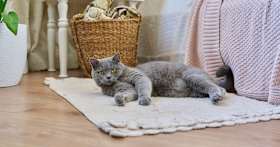
Adoption Advice
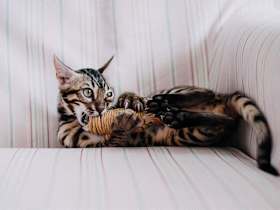
Behavior & Training
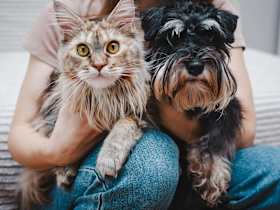
Adoption Advice

Behavior & Training
With a few easy tweaks, you can keep your carpet and your cat happy.
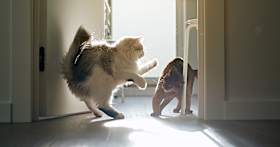
Behavior & Training
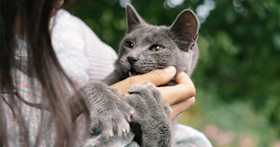
Behavior & Training
Is your new cat giving you the cold shoulder? Here’s how to get them to warm up.

Behavior & Training

Behavior & Training
Is your cat hiding? Don’t worry, it’s totally normal. Here’s how to help them adjust.
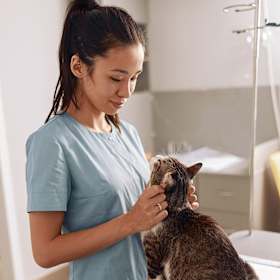
Pet Wellness
Regular vet visits are key to keeping your pet healthy. Here’s what happens during a checkup, when to get them, and what to bring.

Pet Wellness
Emergency help is only a phone call away.

Adoption Advice
If you enjoy silly and entertaining cats, consider an orange one.

Adoption Advice
Although they have a reputation for being independent, cats do still some care and attention.